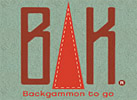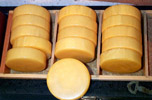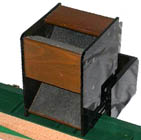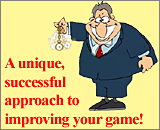Like any other game or sport, if you want to play backgammon well it helps to have the right equipment. The game is also more fun and more fair with the right equipment. Here are my recommendations.
Boards
Let's start with the board. If you are going to play serious backgammon, you absolutely must have a good, tournament size, well-made board. It not only makes the game more enjoyable, it makes the game fairer.
 Poorly made boards simply do not play right. Here are things to look for in a bad board: the checkers don't fit on the pips causing confusion during play; the dice don't roll well, either stopping too soon, bouncing too much making them fly off the board, or often landing on or against other checkers; the coloration is either unclear or distracting because there is not proper contrast between the alternating pips and the color of the checkers. And there are many intangibles that make the better, more expensive boards, simply play better. Poorly made boards simply do not play right. Here are things to look for in a bad board: the checkers don't fit on the pips causing confusion during play; the dice don't roll well, either stopping too soon, bouncing too much making them fly off the board, or often landing on or against other checkers; the coloration is either unclear or distracting because there is not proper contrast between the alternating pips and the color of the checkers. And there are many intangibles that make the better, more expensive boards, simply play better.
Tournament-sized boards are better than smaller boards mostly because there is more room to roll the dice fairly—to be sure they turn several times, and still not end up on top of the checkers or on the floor. The smaller the board, the less the dice turn, and the more likely you are to get repeaters and unfair rolls. And with a larger board, it's easier to see the various plays, and you are less likely to overlook a checker hidden away in a corner somewhere.
 There are many great backgammon boards out there, made all over the world, and you can spend as little as a couple of hundred dollars (which I don't recommend, because the board won't be that good and it won't last), up to thousands of dollars. There are many great backgammon boards out there, made all over the world, and you can spend as little as a couple of hundred dollars (which I don't recommend, because the board won't be that good and it won't last), up to thousands of dollars.
I have owned many boards, and have played on virtually every board out there, and I must tell you I am highly prejudiced. Two of the best known tournament board makers happen to live in Chicago, and I happen to love their boards, and I, and hundreds of tournament players agree, they are both great.
Bob Zavoral has been making leather-covered, custom tournament boards for about 20 years, and it is doubtful that you will go to a major tournament and not see many of his boards there. His boards are meticulously hand-made, and he uses the colors and styles that each client requests. They are beautiful; they play well; they last; and after a few years if you need it recovered, or need the surface of the playing field completely redone, Bob will do it for a reasonable price. His boards sell for around $700, which are less than many other custom made leather boards that, in my opinion, are no better.
There are many other leather board makers that make great boards. BAK boards from Mexico are in the $250 to $400 range; I have a Brazilian board that plays extremely well and is beautiful, and those sell for $500 to $700 and come with a zippered cover. And Aries makes great leather boards that sell for $700 to $900.
 Tak Morioka also lives in Chicago, has been making boards for over 15 years, and he makes the most beautiful hand-crafted wooden boards I have ever seen. I love they way the dice and checkers move on his board, and I have always owned a Taki board (or two) since he started making them. All of his boards are custom made and sell for around $850 and up depending on what you want in the board. Tak Morioka also lives in Chicago, has been making boards for over 15 years, and he makes the most beautiful hand-crafted wooden boards I have ever seen. I love they way the dice and checkers move on his board, and I have always owned a Taki board (or two) since he started making them. All of his boards are custom made and sell for around $850 and up depending on what you want in the board.
You can search on line for boards, but I will tell you now that Carol Cole, out of Flint, Michigan, has been selling backgammon equipment, books, and accessories for over 25 years and she is famous for being reliable and having fair prices. You can see the boards and all other equipment on her site, Backgammon a la Carte. You can e-mail Carol at cjc@flintbg.com. Or you can call her at 810-232-9731. (Note that I am not financially connected with Carol in any way, I just know that she's a terrific source for anything you need.)
Checkers
We will continue our backgammon equipment journey with the checkers;  It is best to buy backgammon checkers with the board, because there must be an exact fit or the board will not play right or close up right. But after a few years, people do see checkers chip, break, or get lost, and you need to get replacement. It is critical to make sure you get exact measurements for both width and diameter. It is also important to make sure you get the right color checkers to go with our board—not just for aesthetics, but to make sure you don't have checkers that blend in with the color of the pips so that you might not see a checker. It is best to buy backgammon checkers with the board, because there must be an exact fit or the board will not play right or close up right. But after a few years, people do see checkers chip, break, or get lost, and you need to get replacement. It is critical to make sure you get exact measurements for both width and diameter. It is also important to make sure you get the right color checkers to go with our board—not just for aesthetics, but to make sure you don't have checkers that blend in with the color of the pips so that you might not see a checker.
I happen to like thick, heavy checkers for two reasons: first, if they are thick, it is less likely that the dice will keep landing on top of them causing excessive rerolling. Second, if they are thick and heavy, it is less likely they will accidentally slide from one place to another if the board or table is hit or knocked into.
Many people, including myself, love the old bakelite checkers—they are thick and heavy, but they also have an indentation in the center which makes them easy to move with one finger. They stopped making backelite checkers, so they are hard to find and expensive, but you can find them on Ebay and other sources from time to time. Again, be very careful of the dimensions.
Dice
If you play serious backgammon, you must use precision dice. The dice have rounded corners so ensure they roll more and to be sure to give you a fairer, more random roll. They are also perfectly balanced, and the clear ones usually have a marking inside. This marking helps prevent someone coming into a game making a dice switch. And a dice switch, or crooked dice, is something that does happen, and has been caught in both money and tournament play.
Crooked dice can be weighted to give the roller more numbers that he wants, or they could have metal inserts or magnets that would attract to magnets in the board to allow the roller to get better dice. If you play for big money, you might check the dice with magnets of your own; you might be sure to use neutral dice and a neutral board, but you are always taking a risk. Even with fair dice, there are dice mechanics and rolling tricks that people have used to get more favorable results.
Cups
There are many great cup manufacturers out there. The important thing is to have a cup large enough so that the dice tumble around inside, but not so large that the dice fall out when you are shaking the cup.
All good cups should have a lip so that the dice hit and come tumbling and rotating out of the cup when rolled. Make sure that when you play for fun, tournaments, or money, that your opponent shakes the dice, up and down, at least 3 times, before rolling. Even if the players are honest, I believe in shaking to make sure you don't get repeating dice.
Other Backgammon Equipment Items
 There are many other accessories you may well want to have once you start playing serious. I personally love a baffle box. It is a box that sits at the end of the board, and you throw the dice into them, and it makes them tumble and rotate before landing on the board. I have two of them, and I use them as often as I can. There are many other accessories you may well want to have once you start playing serious. I personally love a baffle box. It is a box that sits at the end of the board, and you throw the dice into them, and it makes them tumble and rotate before landing on the board. I have two of them, and I use them as often as I can.
I also keep my best boards in a cloth carrying bag to protect the outside of the board. For tournaments, I love to have a scoreboard so that not only do I and my opponent clearly know the score, but anyone who watches will know. Carol sells them for around $30.
I happen to carry a camera with me to take pictures of interesting positions I want to run through Snowie later, but many people mark the positions down on position cards.
I recommend you take some time to look at other people's equipment, and then, before you invest in a good board, dice, cups, etc., do a little web-surfing and see what's out there, but I warn you, if you buy from a stranger on the web, you might well get inferior or damaged goods. If you want to be sure you get quality, and know you can return it if you don't like it, check out Carol Cole. She is the Queen of Backgammon Equipment.
|

